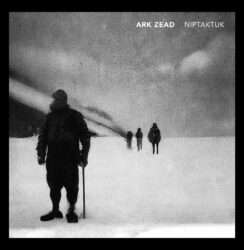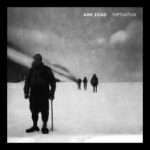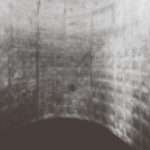ARK ZEAD – NIPTAKTUK
Everything – and I mean EVERYTHING – about this release breathes an extreme cold. Look at the album cover. Look at the track titles, that feel like they come from the Inuit language (although Båken Nunatak refers to a Norwegian-claimed mountain ridge in Antarctica). And – listen to the music!
This music could not have been released on any óther label than Glacial Movements.
No one knows a thing about Ark Zead. ‘No reference sites, no biography, and no place of origin’. The artist describes himself (or herself, but I’ll use him for simplicity’s sake) as ‘a gong and Tibetan singing bowls player, interested in vibes in a very usual way’. A visit to a ‘hostile cold’ Canada inspired him to modify the usual sounds ‘to describe the state of isolationism you have to reach to enjoy the beauty of the True North’.
Well – mission accomplished I’d say!
The cover aesthetics, the track titles, ánd the music itself also triggered another association: this is not unlike the art of Thomas Köner, who also created his first albums with the manipulated sounds of slowed-down gongs (and whose first album release was called Nunatak Gongamur). There are differences … but there are also similarities.
Niptaktuk is definitely a must-check for those of you who love the music of Thomas Köner. But it’s also strongly recommended for those who can appreciate a sound that will lower the temperature in your room by more than a few degrees.
FINAL – WHAT WE DON’T SEE
You may know Justin (K) Broadrick from many other projects he was involved in, solo as well as in groups like Godflesh or Techno Animal. He uses many different aliases – as he puts it himself: “I am sure since I was a child, that within me I am many, I am more than this”.
His Final output is quite different from all that. It is a hazy, impenetrable mist of distorted guitar that works on different levels but probably best when played loud (I mean Sunn O))) loud).
Final (and his listeners) ‘dwell in a foggy and subliminal zone where source materials are submerged, morphed and reborn as wholly different sound-beings’.
There are some more flowery descriptions in the notes about this music, so I’ll just quote here: ‘a record that pierces into the realm of post-experience that exists beyond sense and sensation. It reaches towards the invisible, the inaudible and the intangible and imagines a soundtrack to this non-place’.
What We Don’t See‘s cover is well chosen: this is pretty much the feeling this music evokes. The sound of an invisible world about which Broadrick says: “I find comfort in knowing that this is all not just us here and now, that there’s something else around us”.
If this invisible world is either dark or threatening, or adventurous, or peaceful, is probably in the ear of the listener.





None of this has anything to do with Antarctica — Nunatak is a mountain in Norway. The rest of the track titles, except for “Veryovkina” (the worlds deepest known cave, located in the Arabika Massif in Abkhazia) appear to be from the four languages of Nunavut.
Thanks for your corrections!
I got the information about ‘Båken Nunatak’ from this Wiki-page: https://en.wikipedia.org/wiki/B%C3%A5keneset_Headland , which explicitly mentions Queen Maudland as ‘a region of Antarctica claimed by Norway as a dependent territory’. Maybe ‘Nunatak’ and ‘Båken Nunatak’ do not refer to the same mountain?
But I guess you are right. Anyway, the music is equally cold at both poles 😉